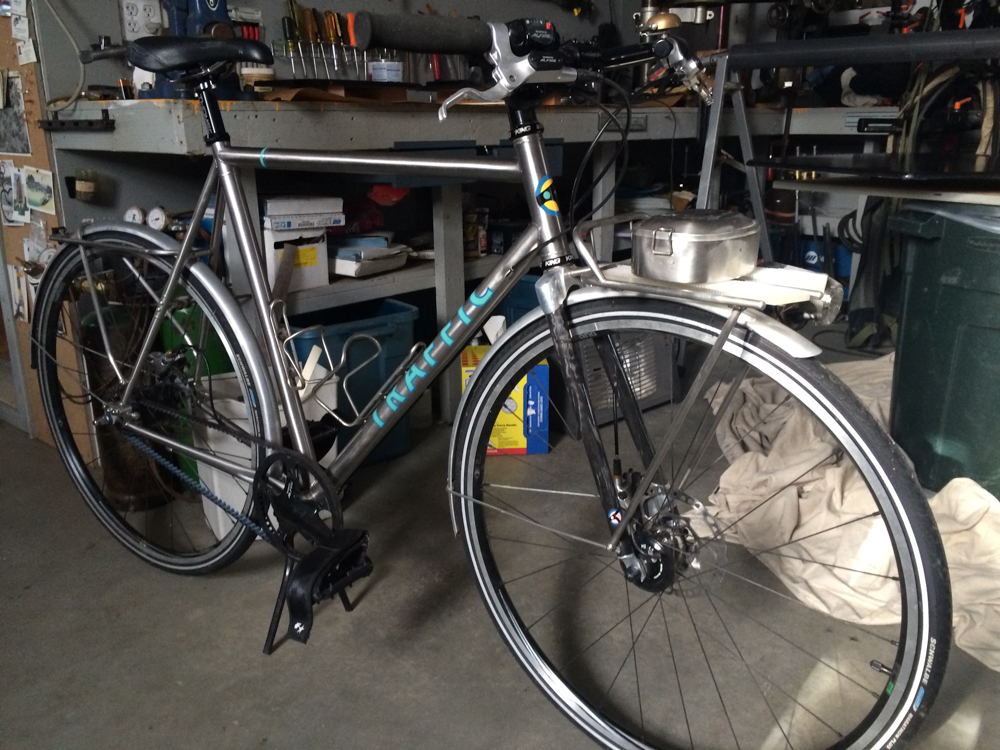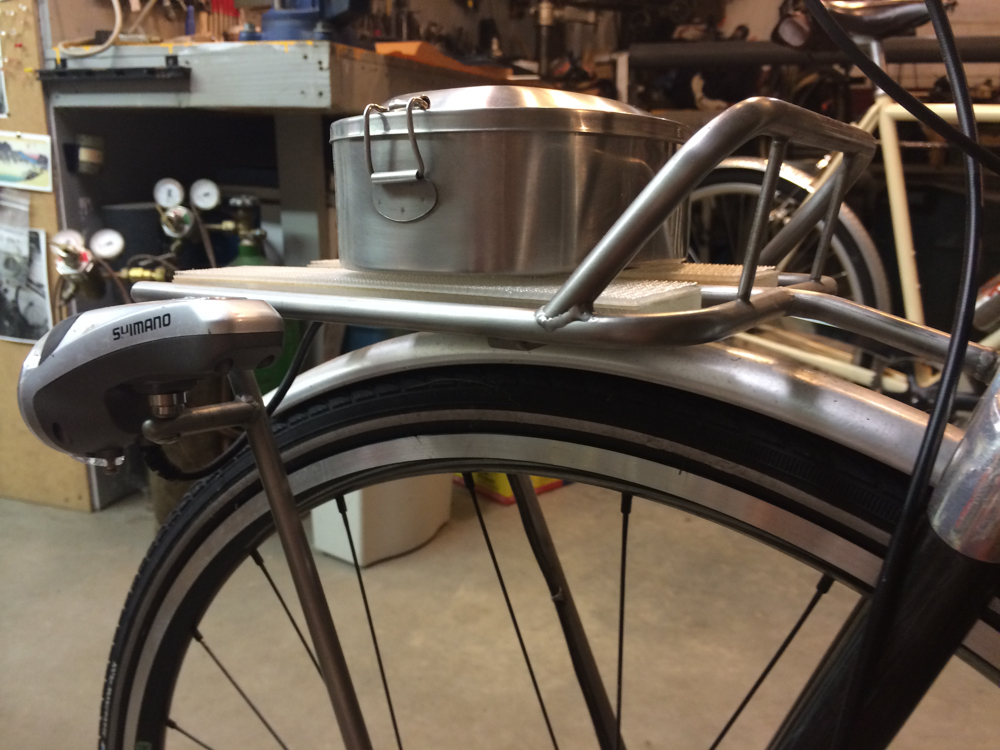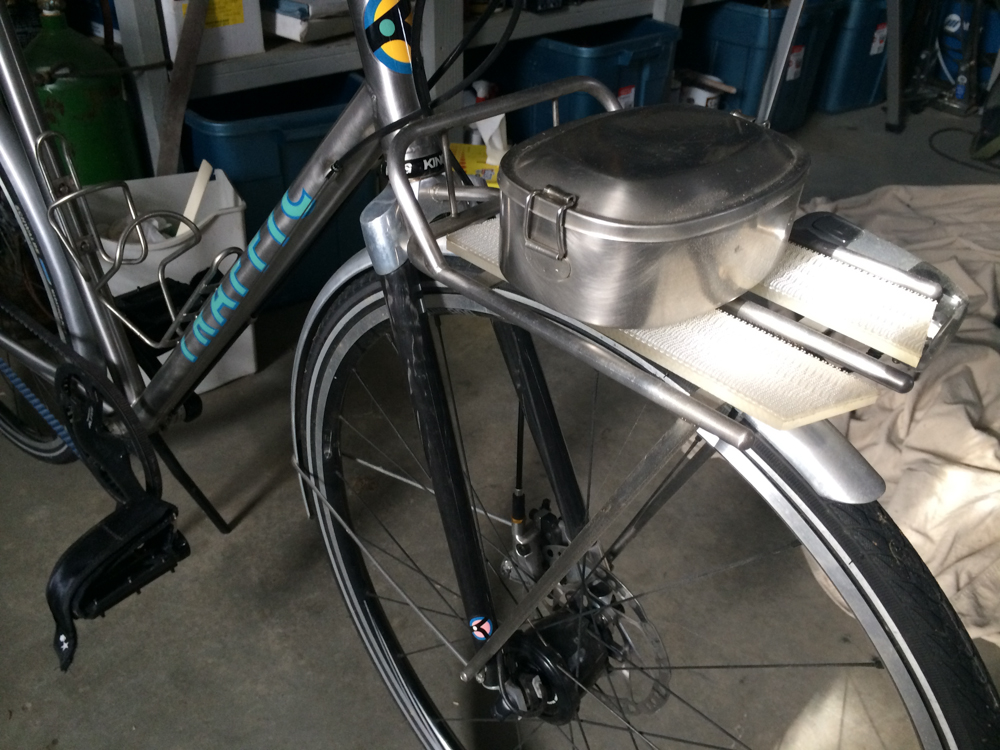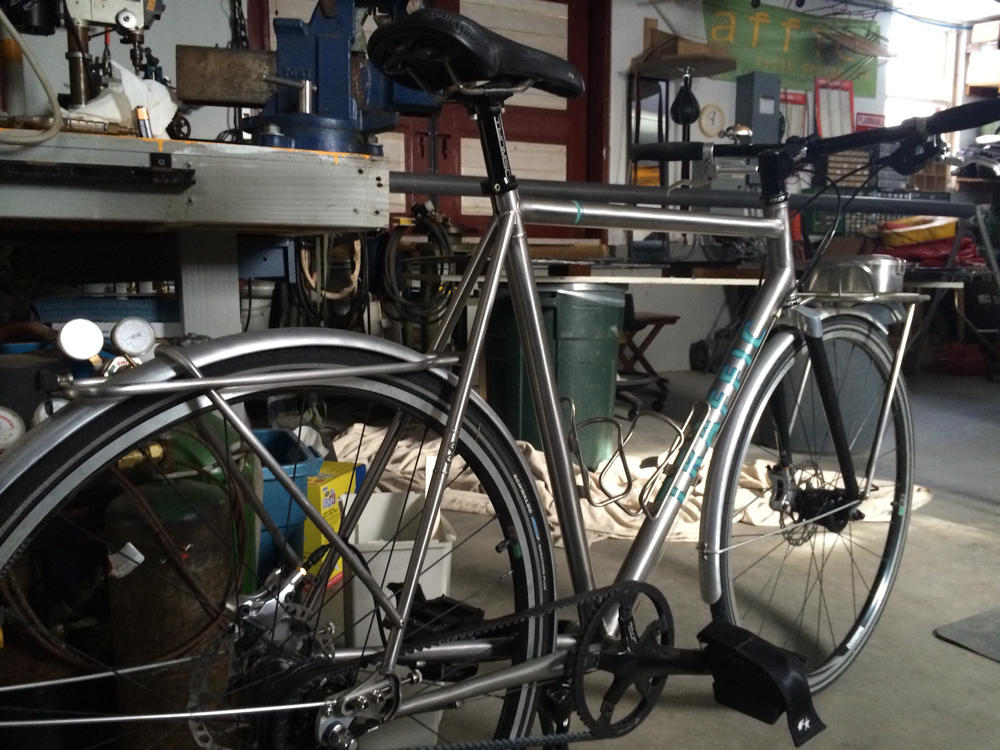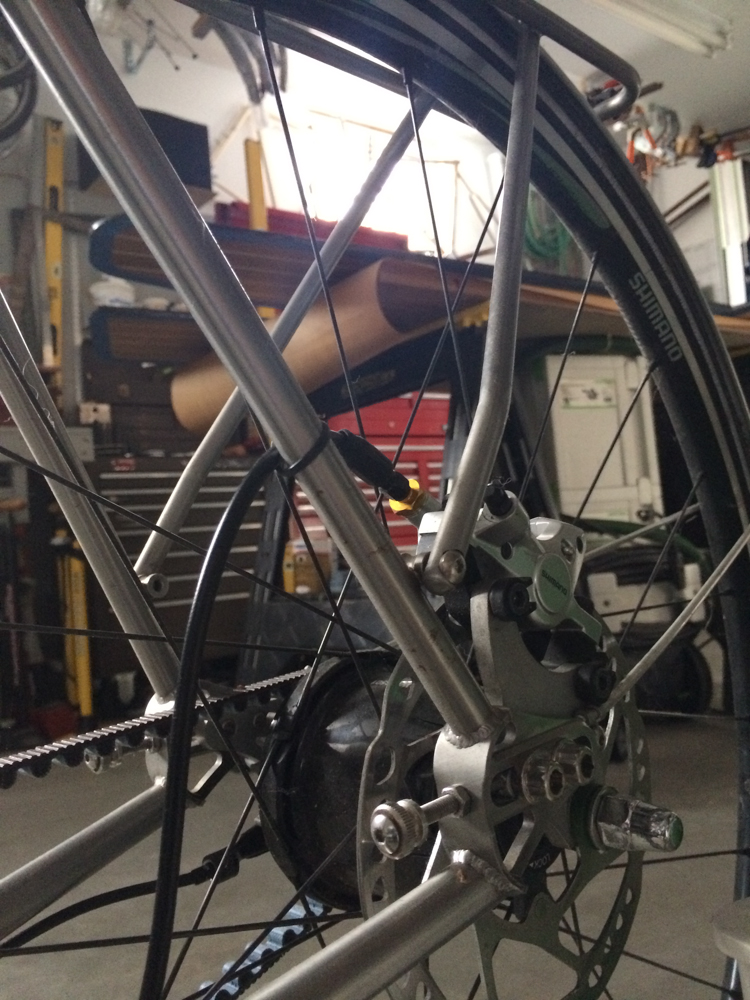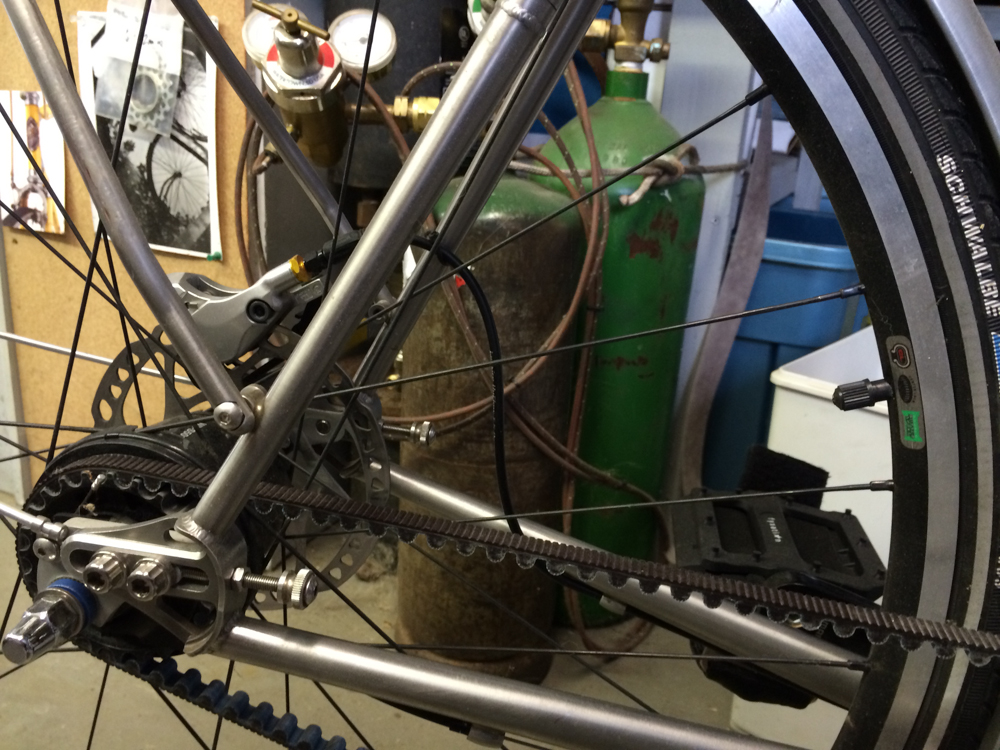I received the shipment of my rack ends yesterday.
Receiving parts is always really fun. I bagged them up into individual shipments last night, and will get them in the mail on Monday.
They're pretty, right?
I received the shipment of my rack ends yesterday.
Receiving parts is always really fun. I bagged them up into individual shipments last night, and will get them in the mail on Monday.
They're pretty, right?
This is from a while ago - late summer 2010. At the time, it was one of my proudest pieces of physical output, but somehow I never got around to properly sharing it on the internet. I never photographed it properly either, so these iPhone shots will have to do for now :/
I love the belt drive, but am now quite a bit less enamored of the Alfine setup. The frame is pretty awesome, though (it's all Reynolds 953 mar-aging stainless steel), and I'm *really* proud of the racks.
This bike was the real impetus for me to make my own rack ends. I also made a few other little bits on the bike, including a pretty cool seatstay bridge with hidden fasteners for the rear rack.
Incidentally, the mushroom-head velcro on the front rack is a pretty slick way to attach commonly used things to a rack surface.
As described here, my 4-A rack ends grew out of a much simpler design that I had watercut out of stainless steel plate in 2010.
As it happens, I've got about 40 of these little guys left, and I'm glad to offer them as "cherry on top" rewards for anyone who backs my Indiegogo campaign. If you're a backer, I'll offer you a 50% match on these parts. In other words: you buy 16 of my 4-A rack ends, and I'll give you 8 of these plate ends. Just shoot me an email and tell me how many 4-A ends you've pledged for, and I'll add these to your order for no additional charge. I've only got a limited quantity of these, so give me a holler soon!
These are actually pretty great rack ends, and I'm sure that plenty of builders would get good use out of them!
The time has come: My rack ends are on Indiegogo.
This project has been in a weird filler state for a while, but I finally sat down and worked out my pricing structure and launched the campaign last night - and I'm excited to get it off the ground! In the interest of clarity, I'm disclosing a lot of information here about the development process and my pricing/cost structure.
After receiving a number of quotes from around the world, I decided to go with a supplier who I have a good professional relationship with: Mattson-Witt Precision of Barrington IL. In 2011 and 2012, I sourced many thousands of dollars of parts from them, and the results were excellent. I have clear lines of communication with the director of operations and consider them a partner in this project. Incidentally, they were *not* the cheapest bid I received - their quote fell somewhere in the middle of the pack - but their delivery timetable was good and I can trust that they'll stick to their word.
When I first resurrected this project, I posted a bit of background on the design here and shared it with the framebuilding community. I received a bit of interest and some informal preorders, and based my RFQ quantities around an extrapolation of that data. I wanted the retail price of the parts to be similar to other similar parts on the market, and also wanted to offer quantities that made sense to my customers.
The price from the machine shop is $5.07 apiece at a quantity of 150 (I had tentative preorders of about 90). The retail price structure is as follows:
If I sell just 150 parts, my net income tops out at $516.75 and tapers down from there - precipitously, if I get a few large orders. My hope is that I can sell more that 150 parts and increase my order quantity accordingly. At quantities of 500, I expect my wholesale price to be closer to $4 each, which obviously means more money in my pocket. My best case scenario is that I pre-sell enough parts to justify folding my profits into a larger order, which I can then sell to new or repeat customers down the line. I hope to determine the order quantity by early-mid February (a few weeks before the campaign ends) and be able to place my order so that it's delivered right after my funding date. That way I can be ahead of schedule on shipping and ensure that none of my customers are put out by delays.
A note about shipping and handling: I was a little unclear on how to deal with this, and decided in the end to apply a $5 flat S&H fee to all orders. I suspect that I'll be in the black on small orders, but on larger quantities that'll probably change quickly. I'm not investing in any fancy packaging - I'll probably do a small ziploc bag from McMaster + a small plain envelope - so all I need to recoup is the actual shipping charges and my time counting and bagging the parts and getting them to the carrier (likely USPS).
I'll be updating this project as I near my funding goals. If anyone has *any* questions about the design, how the parts are used, or the cost structures I've listed here, please comment below - and thanks for your support!
NOTE: For anyone who's curious, you can see a fully dimensioned drawing of the parts here!
A week or two ago I posted a really great quote that I received on MFG. This one is on the opposite end of the spectrum.
Note that although I specified DDP terms, the supplier (a middleman for overseas outsourcing) has quoted FOB China.
The price is also totally noncompetitive. I hope to purchase these parts from a US supplier for under $3 apiece at this quantity - and I don't want to be waiting 6 weeks for a boat to show up, either. At larger quantities (1000s) I'd hope to be paying more like $1.75 to my door.
For traditionally manufactured parts, MFG has a large enough supplier network that you almost always get a handful of good quotes. My rack end, for instance, went out to over a thousand suppliers. About 75 viewed the RFQ, and to date I've received 7 bids. Another dozen or so suppliers are apparently "preparing quotes."
When you shrink the pool down, though, the rates matter a lot more. There are a *lot* of swiss turning shops in the US, but very few that can produce DMLS titanium parts. So when I posted my seatmast topper, I tracked the results with a lot more interest.
The RFQ went out to 110 suppliers. 8 viewed it, and I have yet to receive a single quote.
Incidentally, there is at least one supplier on this list who did *not* view the RFQ but whom I found separately via Google.
The thing that really strikes me here is MFG's total incapacity to move my project forward - quotes or not. In optimal situations, MFG is an effective marketplace to compare quotes for manufactured parts. What it's not good at, however, is the broader function of connecting designers with manufacturers. Anything I want to learn about the DMLS process - information that inevitably is going to come directly from the engineers and operations managers that are quoting and building my parts - is totally missing from the MFG experience. Instead, I'm left to do leather-to-the-ground work the same way I always have: an afternoon spent with Google + a phone line.
There's definitely a place in the world for a manufacturing marketplace, but I'm pretty sure this could be better.
Regardless, I'm beginning to develop a few old-fashioned leads on good DMLS job shops, and I hope to have some real - and reasonable - pricing in the next few days.
Most quotes on MFG - whether from the US or overseas - leave a lot to be desired. This one is pretty good, though.
Note, that doesn't mean that I'm going to act on this quote. But I like the comments a lot - they show a lot of foresight and care on the part of the supplier.
I've been really lagging on my rack ends project, but I wanted to post a quick update.
A few months ago I posted drawings and a STEP file to MFG.com. MFG is a sourcing platform for manufactured parts of all types, with suppliers and buyers from around the world. When I was building robot doors, I used MFG to source probably $50k worth of parts, mostly from contract machine shops around the US - but also from mainland China. MFG is a great place to get a *lot* of quotes quickly, and I've developed a few long-term relationships with great suppliers from it.
My current project is a small one - there are certainly hundreds of job shops around the country who could handle it. I'm hoping to spend $2-3 per part in quantities in the 100s, though it remains to be seen whether that's possible.
I got about twenty quotes back, though I scratched a few outliers off the bat. The remaining sixteen are below. Note that the 1st quantity is for 1000, 2nd quantity is for 100.
As it happens, I've received samples from a few of the cheapest suppliers on this list... they were pretty rough, with a lot of hand-finishing (presumably to cover up low quality machining).
Note also that I requested all pricing to be DDP, which means that the supplier is supposed to include all duties and shipping to my doorstep. From my past experience, a lot of Chinese suppliers either don't understand or don't care to quote these terms, though a few of the quotes here actually specify EXW, meaning that the supplier boxes up the goods and then leaves the rest for me to take care of. For a box of stainless steel in Guangdong, the cost of shipping could easily add 25-50% to some of these cheaper quotes.
For a part like this one, I could probably pick one of the lower bids and go with it. The part is simple enough; the worst I would deal with would probably be a bit of slag on some of the drilled holes. I want to be careful about material selection, though - I need the part to be 304 stainless, and the risk of a supplier using a different grade is nontrivial.
The fun thing to do is to order the small quantity from one of the lowest bidders, and see how it turns out. For less than the cost of a used PS3, you can get a batch of parts that's probably ready to sell or use - *and* you might learn something interesting.
In reality, I'm more likely to buy the parts from a supplier I know (and found on MFG a few years ago). The quote I got from him was under $4 per, which is competitive with many of the Chinese suppliers here. He quotes EXW, but shipping UPS for these parts won't be more than $50. I would also follow up with all of the reasonable US firms here and see what their responsiveness was - especially if I can find someone local-ish.
This particular part is low priority right now, but I'll probably follow up on this early in January. Expect updates.
I'll be writing more about how I'm going about procuring my stainless steel rack ends later, but I wanted to give an idea of the sorts of design files one needs to supply machine shops with in order to get quotes. A dimensioned (and toleranced!) PDF is always key:
N.B., my drawing template is pretty lame right now. Not having standard tolerances listed is a total no-no, but most manufacturers assume +/- .005" on any distance and +/- 1 degree angular - so I should be okay. I really just need to spend a morning setting up a new template, but that's fairly low on my priority list right now. Anyway... do as I say, not as I do.
I also usually include a STP file, but as a rule that's *only* for reference. I suppose that if you had a particularly strong relationship with a supplier and were sourcing a part with *only* standard tolerances, skipping the PDF would be okay... but that's a rare scenario.
Aaaand, thanks to my friends on Twitter, you can see the part in 3D here:
BK1008 Rack End from SpencerWright on Sketchfab.
In the past few weeks, I've been reviving a product that I originally conceived of in 2010. I'll get more into its revival later, but I wanted to spend a little time documenting the development and design details here.
It was sometime in 2009 that I decided that rackbuilding was something I wanted to focus on. I had been building custom bike frames full-time for a year and a half, and had developed a sense that for most customers, custom frame geometry alone is just not sufficient reason to justify spending $3K+ on a bike. I had built a few nice road and mountain bikes in the $5-7K range, and I was proud of the results, but the value proposition for most customers just wasn't there. For that money, you can buy one hell of a Specialized off the rack at a LBS. And other than a sotto voce paint job (I tend to *hate* the design language that the big bike companies use), there was little I could offer to really distinguish myself.
I also wasn't totally immune to spotting trends. In March of that year, I attended a trade show and spent a while observing the way other folks were differentiating themselves. Fashion in the handmade cycling world tends towards the quaint, and rackbuilding offers framebuilders the opportunity to show their bikes carrying things like wine bottles and six-packs - stuff that most big companies would never display.
Around this time, I was living in Philadelphia and spending a lot of time biking around and eating pizza. I spent a while thinking about what kind of rack I'd want for my bikes, and the best combination of whimsy and utility that I could come up with was a front rack that would fit a large pie. I was riding around a hardtail mountain bike at the time, and decided to build up what would become The Utility Bike - and, once it was mostly done, went about building my first real rack.
At the time, most custom builders were just cutting their own rack eyes out of plate or bar stock (Rack Lady, who I have a *lot* of respect for, is/was a great example of this). A few folks (Signal stands out) were doing really beautiful things that more closely emulated lugged construction, but that was never really my aesthetic. Anyway, I wanted my rackbuilding process to be TIG only.
I started by having a bunch of plate-style eyes watercut from a sheet of stainless plate. The plate was .125" thick and came with a stain finish. The result was a pretty good start.
I used these on a couple of racks, and all in all they were a great improvement over cutting them by hand. I tried a few different methods. In at least one case I crimped the rack tubing over the tab itself, but it was a bit cleaner to slot the tubing and insert the tab into the slot. Welding the whole thing together was a bit sloppy (The wall thickness on the rack tubing is .028", which contrasts badly with the .125" thick plate eyes. The result is that keeping both parts right at melting temperature is tricky.) , but the result was passable.
This was my first nice rack. I eventually got Ian to make me some slats to fill in the deck and, and I made some custom length bungees too. I learned a lot in the process, and also tried out a detail that - although kind of silly - would end up informing the way my rack end design progressed. The rack required that a few tubes be terminated, and I turned down some solid stock to a point, relieved an area to insert into the tube, and lap welded the entire thing together. The result is below.
Right around this time, I started building bikes for both Saylor and Ian. Both required racks, and Ian got a chainguard as well. I spent a little while thinking about how to terminate all the tubing, and ended up making a batch of mill-turned rack ends that would become my go-to solution on a bunch of future projects. The process went turn-mill-turn, and included at least ten processes per part, described roughly below:
The end result can be inserted into a piece of .375"x.028" tubing (cut square) and lap welded. I generally would then file and sand the result smooth. This assembly technique offered me a key feature: If a strut was just slightly too long, I would shorten it (by rolling it against a benchtop disc sander) quickly and in small increments. In addition, the entire assembly is self aligning - the rack end bolts to the boss and slips into the tube, which can have any orientation necessary. This method was much easier than if I had been using tabs & slots, which take a lot of work to align just right and is difficult to adjust the length of.
I got a lot of mileage on these parts, and adapted them for a few alternate configurations as well. I developed something of a symbiotic relationship between their design and my rackbuilding workflow, and the result has been (to me) great.
I think these parts could be useful to a lot of framebuilders out there, and I'd be interested to hear from anyone who might be interested in them. Drop me a line if that sounds like you.
